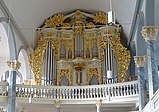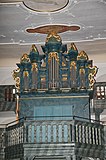Hey organ building
| Hey organ building | |
|---|---|
| legal form | one-man business |
| founding | 1874 |
| Seat | Ostheim , Germany |
| management | Herbert Hey |
| Branch | Musical instrument making |
| Website | www.hey-orgelbau.com |
The organ building company Hey Orgelbau is based in the Rhön in Ostheim in the district of Urspringen and is based on the Rhön organ building tradition , which goes back about 250 years.
history
The company's founder, Wilhelm Hey, was initially a carpenter in his father's workshop and, at the suggestion of Michael Katzenberger, switched to organ building. He learned the craft at Randebrock in the Westphalian town of Paderborn, where he made it to the position of foreman. In 1870 he went to the USA on behalf of his master to set up a large organ in Detroit . In Germany, Wilhelm Hey was working on organs in Warburg, Werl, St. Walburga and Corvey at that time.
When Michael Katzenberger died in 1874, Wilhelm Hey returned home, equipped with qualified knowledge and extensive experience, and at the age of 34 took over his clientele and workshop. The 125th anniversary of Hey was founded on this date.
Wilhelm Hey quickly won the trust of customers at the border triangle of Thuringia, Hesse and Bavaria. He built the new organs with classicist rectangular or arched prospects. His works still testify to the high level of craftsmanship and artistic skill. Numerous certificates and reports speak for the high quality of the work , for the skill and craftsmanship of the old master. The following testimony provides information about Wilhelm Hey's working method, which the bishop's organ expert and city cantor Johannes Gesang from Fulda wrote about the repairs in the Catholic Church Hofbieber-Kleinsassen in 1884 and 1885; it is said:
“At the request of the praiseworthy church council of the parish, I examined the work described above on June 8th. Mr. Hey carried out the work listed in the attached cost estimate on time and precisely. The pipework is in the best condition, the new pipes are neat and clean, and the three basses have also been thoroughly repaired. [...] The mechanics and the government work are well prepared. The two bellows are also very good and durable. […] Intonation and tuning leave nothing to be desired either. I can only express my full satisfaction to Mr. Hey and praise that, with modest demands, he carried out the repairs with a lot of skill, diligence and great perseverance and thus demonstrated his proficiency in organ building in the best possible way, which I would recommend to everyone. "
The sons Otto and August Hey
Wilhelm Hey's son Otto Hey was a sensitive, musical man. He learned the trade from his father and took over the workshop at an economically difficult time. At that time, new construction contracts were not available in the poor Rhön. He mainly carried out renovation, repair and tuning work.
Wilhelm Hey's second son August Hey first worked as an organ builder for his father. Later he started an apprenticeship at a textile company in Leipzig and went abroad. He achieved wealth and prestige. Wilhelm Hey's daughter, Ida Hey, married in the Held-Mühle in Heufurt: “Flour, bread - without need”, that was the father's diction.
Erich Hey learned the organ building trade from his grandfather Wilhelm Hey and after his death he finished his apprenticeship with his father Otto Hey. The adolescent developed great talent at a young age. Outside of school he worked in the workshop of his grandfather Wilhelm.
He expanded his knowledge of organ building in 1925/26 with Steinmeyer in Oettingen and in 1926/27 with Paul Faust in Schwelm / Westphalia. From mid-1927 he worked again in his father's company. On July 8, 1936, Erich Hey passed his master's examination in Weimar and took over the organ building workshop, which he later moved to today's Hauptstrasse in Sondheim / Rhön. Erich Hey was considered a great musician: he played seven instruments with mastery, was also cantor and choirmaster in Sondheim / Rhön and gave music lessons in the evenings.
Wolfgang and Gotthard Hey
Wolfgang Hey learned the organ building trade from his father Erich Hey and expanded his knowledge, among others, at Steinmeyer in Oettingen, where his father had already learned. After the sudden death of his father in 1962, he took over the organ building business in a uniquely difficult time. Together with his brother Gotthard Hey, he relocated the workshop from Sondheim / Rhön to neighboring Urspringen / Rhön. Gotthard Hey learned the organ building trade from his father and from Kreienbrink in Osnabrück.
With a growing volume of orders and personnel, Wolfgang Hey built a completely new workshop in 1972. The state-of-the-art factory, exhibition, storage, restoration, construction and office rooms cover a size of 2,100 square meters. Organ works of almost any size can be built or professionally restored here.
Wolfgang Hey gained the trust of numerous organ experts and church communities and was able to expand his work area considerably despite the difficult economic situation on the edge of the zone.
The official organ expert of the Archbishop's Ordinariate Bamberg, Domkapellmeister Wolfgang Wünsch, wrote the following as an assessment: “Since 1969, Mr. Hey has built several slider-chest organs in the area of the Archdiocese of Bamberg; the mechanical action mechanism was generally preferred. I am happy to confirm that all of the organs built by Mr. Hey in my service area are instruments that are far above average in terms of their technical and craftsmanship, but also in terms of their artistic quality. The tasteful intonation and absolute functional reliability round off the overall picture in the best way. "
In 1993, Wolfgang Hey handed over the flourishing, economically healthy organ building business to his two sons, who had been responsible for the business for years.
Herbert and Erhard Hey
Herbert and Erhard Hey are the two sons of Wolfgang Hey. Both learned the organ building trade abroad, they passed their master's exams in organ and harmonium building in 1975 and 1984. From 1993 to 1995 both ran the business. In addition to the numerous new and reconstructed organs, there was and still is a particular interest in restoring historical organ works in keeping with the style.
In 1996 Herbert Hey took over the organ building business. With the support of his brother Erhard, the new organ works are designed and manufactured strictly according to classical principles, but without completely neglecting the achievements of contemporary organ building. In 1998 Herbert Hey received the certificate of restorer in the organ and harmonium building trade from the Stuttgart Chamber of Crafts. This makes the Hey workshop one of the oldest organ building workshops in Germany. It has been based in Urspringen / Rhön since 1963. Today it is run by Herbert Hey, whose sons Thomas and Christian are the sixth generation.
List of works (selection)
| year | place | church | image | Manuals | register | Remarks |
|---|---|---|---|---|---|---|
| 1970 | Hayurt | Saint James the Elder |

|
II / P | 13 | |
| 1974 | Redwitz ad Rodach | Catholic Curate of St. Michael | II / P | 21st | ||
| 1980 | Bad Orb | Catholic Church | III / P | 37 | ||
| 1982 | Burghaslach | St. Aegidius | II / P | 28 | ||
| 1985 | Ochsenfurt | Protestant church | III / P | 24 | ||
| 1986 | Bad Windsheim | St. Kilian | IV / P | 60 | ||
| 1992 | Bad Berneck | Protestant church | III / P | 28 | ||
| 1993 | Kronach | Catholic Church | III / P | 38 | ||
| 1997 | Sondershausen | St. Trinity |

|
III / P | 46 | |
| 2001 | Oberhausen | Evangelical Christ Church |

|
III / P | 32 | |
| 2004 | Mellrichstadt | Catholic Church | III / P | 42 | ||
| 2008 | Schleusingen | St. Johannis |

|
III / P | 39 | |
| 2011 | Yeosu, Korea |
Vox Maris , built for Expo 2012 |

|
I / P | 1 | Loudest organ in the world with 138.4 dBA (Guinness World Record) |
literature
- Company brochure 250 years of organ building in the Rhön
- Gottfried Rehm from Acta Organologica Vol. 7, 21 and 25
Web links
- www.hey-orgelbau.com Website of the company


